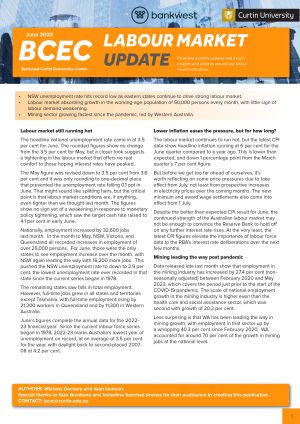BCEC Monthly Labour Market Update – June 2023
— NSW unemployment rate hits record low as eastern states continue to drive strong labour market. —
— Labour market absorbing growth in the working-age population of 50,000 persons every month, with little sign of labour demand weakening. —
— Mining sector growing fastest since the pandemic, led by Western Australia. —
Labour market still running hot
The headline national unemployment rate came in at 3.5 per cent for June. The rounded figures show no change from the 3.5 per cent for May, but a closer look suggests a tightening in the labour market that offers no real comfort to those hoping interest rates have peaked.
The May figure was revised down to 3.5 per cent from 3.6 per cent and it was only rounding to one-decimal place that prevented the unemployment rate falling 0.1 ppt in June.
That might sound like splitting hairs, but the critical point is that labour market conditions are, if anything, even tighter than we thought last month.
The figures show no sign yet of a weakening in response to monetary policy tightening, which saw the target cash rate raised to 4.1 per cent in early June.
Nationally, employment increased by 32,600 jobs last month.
In the month to May, NSW, Victoria, and Queensland all recorded increases in employment of over 25,000 persons.
For June, those were the only states to see employment increase over the month, with NSW again leading the way with 16,200 more jobs.
This pushed the NSW unemployment rate to down to 2.9 per cent, the lowest unemployment rate ever recorded in that state since the current series began in 1978.
The remaining states saw falls in total employment. However, full-time jobs grew in all states and territories except Tasmania, with full-time employment rising by 21,200 workers in Queensland and by 11,300 in Western Australia.
June’s figures complete the annual data for the 2022-23 financial year.
Since the current labour force series began in 1978, 2022-23 marks Australia’s lowest year of unemployment on record, at an average of 3.5 per cent for the year, with daylight back to second-placed 2007-08 at 4.2 per cent.
Lower inflation eases the pressure, but for how long?
The labour market continues to run hot, but the latest CPI data show headline inflation running at 6 per cent for the June quarter compared to a year ago. This is lower than expected, and down 1 percentage point from the March quarter’s 7 per cent figure.
But before we get too far ahead of ourselves, it’s worth reflecting on some price pressures due to take effect from July, not least from prospective increases in electricity prices over the coming months. The new minimum and award wage settlements also come into effect from 1 July.
Despite the better than expected CPI result for June, the continued strength of the Australian labour market may not be enough to convince the Reserve Bank to hold off on any further interest rate rises.
At the very least, the latest CPI figures elevate the importance of labour force data to the RBA’s interest rate deliberations over the next few months.
Mining leading the way post pandemic
Data released late last month show that employment in the mining industry has increased by 27.4 per cent (non-seasonally adjusted) between February 2020 and May 2023, which covers the period just prior to the start of the COVID-19 pandemic.
The scale of national employment growth in the mining industry is higher even than the health care and social assistance sector, which was second with growth of 20.2 per cent.
Less surprising is that WA has been leading the way in mining growth, with employment in that sector up by a whopping 40.3 per cent since February 2020.
WA accounted for around 70 per cent of the growth in mining jobs at the national level.




